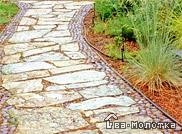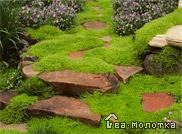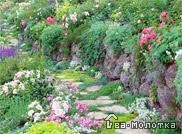Natural stone in exterior design – natural simplicity

Landscaping is a way of creating a harmonious space using natural elements. The highest class in landscape design is the subtle combination of all elements (stone, glass, plants, water), when a complete picture is created, filled with meaningful elements.
Creating a beautiful natural area is no easy matter, though, and a number of technical factors need to be considered. You need to have a vivid imagination and be able to combine different natural elements. Natural stone is a universal assistant to the landscape designer. It helps to give a finished look to a landscape picture, wher natural stone elements set logical accents in the composition.
Natural stone – ideal material for use in landscape design
Natural stone is the link that unites all elements of landscape composition. The advantages of using natural stone prevail, and there are hardly any disadvantages.
Natural stone is ideally combined with other materials such as wood, metal, or glass. Even floral arrangements, or water objects are decorated with natural stone.
The variety of shades offered by natural stone enables landscape designers to create any picture imaginable. Paving paths, creating mosaics in various colour shades – all this is possible using natural stone.
Natural stone used in landscape design – marble, granite, limestone – is durable, does not require special care, is resistant to weather and temperature changes.

Unprocessed stones (boulders) as well as processed ones used for paving paths, platforms, creation of fountains, sculptures, benches, or arbours are used in landscape design.
Pathways and platforms from natural stone
Natural stone opens up a wide range of possibilities for paving paths. In addition to the wide colour range, resistance to abrasion and resistance to temperature changes, limestone, marble and granite are perfectly amenable to different kinds of shaping. Thus, natural stone paving can look like a granite paving, and as an exquisite mosaic panel. In terms of shape, natural stone tiles can appear in the form of a coil, barrel, fan, clover, dolphin or trapezoid.
Natural stone paths and squares are tiled with flat tiles, slabs or specially created rough cobblestones, giving the landscape a natural look.
The combination of homogeneous stone texture of paths and other garden elements – sculptures, benches, pergolas, will give the landscape a finished look.
A garden path is a technically complex structure, so the choice of path material and paving specialists must be made with the utmost care. Specialists should determine the quality of the soil and the desired level of groundwater.
It depends on the condition of the soil whether it is possible to save money and make easier paving with natural stone, or lay the path in accordance with the full technological cycle (filling crushed stone, sand, drainage, etc.). The purpose of the path should also be taken into account. Pathway for the garden or driveway to the garage will be different as will be the material and method of installation, because the load on the stone will be totally different.

Tiles for paving have a lot of varieties, among the most common: granite pavers, parquet, wave, classic, tulip. There are many ways of laying tiles, the most popular are parquet laying, fan, basketry, or English stringing.
It should be noted that patterned masonry began to be fashionable, which involves insertion of gravel, sea pebbles, natural stones, coloured glass. Patios (inner courtyards of country houses and cottages) are decorated in this way.
Besides the functional load, garden paths have another important aesthetic task. They can be used to transform any landscape, make it more interesting and conceal flaws in the terrain.
Source: www.dvamolotka.ru
